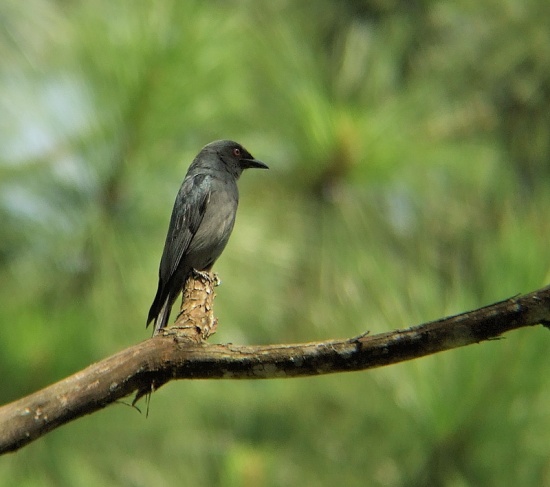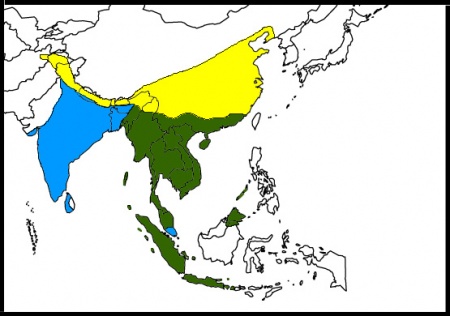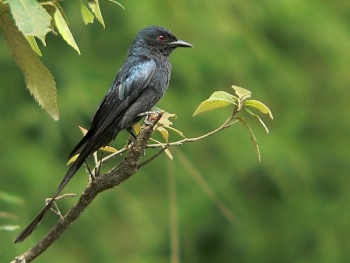(taxonomy, id of ssp expanded) |
(picture of nominate added, alternative names) |
||
| Line 1: | Line 1: | ||
| − | [[Image: | + | [[Image:DSCF6747 ashy drongo.jpg|thumb|550px|right|nominate subspecies<br />Photo by {{user|horukuru|horukuru}}<br/ >Cibodas Garden, Gede, Java Island, May 2008]] |
| + | '''Alternative names: Pale Drongo, Grey Drongo''' | ||
;[[:Category:Dicrurus|Dicrurus]] leucophaeus | ;[[:Category:Dicrurus|Dicrurus]] leucophaeus | ||
| − | |||
==Identification== | ==Identification== | ||
Size: 23 - 30cm. A variable drongo: | Size: 23 - 30cm. A variable drongo: | ||
| Line 29: | Line 29: | ||
====Subspecies<sup>[[#References|[1]]]</sup>==== | ====Subspecies<sup>[[#References|[1]]]</sup>==== | ||
There are 14 subspecies; | There are 14 subspecies; | ||
| − | *''D. l. longicaudatus'': Eastern [[Afghanistan]] to Sikkim; winters to southern [[India]] and [[Sri Lanka]] | + | *''D. l. longicaudatus'': Eastern [[Afghanistan]] to Sikkim; winters to southern [[India]] and [[Sri Lanka]] ('''Indian Grey Drongo''') |
::* head and upperparts almost black, long and deeply forked tail | ::* head and upperparts almost black, long and deeply forked tail | ||
| − | *''D. l. hopwoodi'': Eastern [[Himalayas]] to [[Burma]] and southern [[China]]; winters to [[Indochina]] and eastern [[India]] | + | *''D. l. hopwoodi'': Eastern [[Himalayas]] to [[Burma]] and southern [[China]]; winters to [[Indochina]] and eastern [[India]] ('''Assam Grey Drongo''') |
::* unglossed blue-grey, but variable in size and colour | ::* unglossed blue-grey, but variable in size and colour | ||
*''D. l. mouhoti'': Southern [[Burma]] and northern [[Thailand]]; winters to [[Indochina]] | *''D. l. mouhoti'': Southern [[Burma]] and northern [[Thailand]]; winters to [[Indochina]] | ||
::* blue grey above and pale soft ashy grey below, ear-coverts lighter grey | ::* blue grey above and pale soft ashy grey below, ear-coverts lighter grey | ||
| + | [[Image:Ashy_Drongo.jpg|thumb|350px|right|ssp ''longicaudatus''<br />Photo by {{user|Rajiv+Lather|Rajiv Lather}}<br/ >Himachal Pradesh, [[India]]]] | ||
*''D. l. bondi'': Southern [[Thailand]], southern [[Laos]], southern [[Vietnam]] and [[Cambodia]] | *''D. l. bondi'': Southern [[Thailand]], southern [[Laos]], southern [[Vietnam]] and [[Cambodia]] | ||
::* like ''mouhoti'' but smaller and paler | ::* like ''mouhoti'' but smaller and paler | ||
| − | *''D. l. nigrescens'': Extreme southern [[Myanmar]], southern [[Thailand]] and [[Malaysia]] | + | *''D. l. nigrescens'': Extreme southern [[Myanmar]], southern [[Thailand]] and [[Malaysia]] ('''Burmese Grey Drongo''') |
::* plumage is black with slight gloss above and darker below. Resembles [[Black Drongo]] in shape andd proportions but is never as black. | ::* plumage is black with slight gloss above and darker below. Resembles [[Black Drongo]] in shape andd proportions but is never as black. | ||
| − | *''D. l. leucogenis'': Manchuria and eastern [[China]]; winters to [[Indochina]] | + | *''D. l. leucogenis'': Manchuria and eastern [[China]]; winters to [[Indochina]] ('''White-cheeked Grey Drongo''') |
::* pale ashy grey with white cheek patch, including area surrounding eyes. | ::* pale ashy grey with white cheek patch, including area surrounding eyes. | ||
*''D. l. salangensis'': South-eastern [[China]] and southern [[Thailand]]; winters to Hainan | *''D. l. salangensis'': South-eastern [[China]] and southern [[Thailand]]; winters to Hainan | ||
| Line 55: | Line 56: | ||
*''D. l. siberu'': Siberut Island (off [[Sumatra]]) | *''D. l. siberu'': Siberut Island (off [[Sumatra]]) | ||
::* slightly darker than ''periophthalmicus'' | ::* slightly darker than ''periophthalmicus'' | ||
| − | *''D. l. leucophaeus'': [[Java]], [[Bali]], Lombok, Palawan, Calamian and Balabac islands | + | *''D. l. leucophaeus'': [[Java]], [[Bali]], Lombok, Palawan, Calamian and Balabac islands |
::* Ashy grey plumage. dark on throat and underparts with velvety dark frontal band and blackish chin | ::* Ashy grey plumage. dark on throat and underparts with velvety dark frontal band and blackish chin | ||
Two subspecies ''Dicrurus l. celaenus'' and ''Dicrurus l. palawensis'' are not recognised by all authorities.<sup>[[#References|[1]]]</sup> | Two subspecies ''Dicrurus l. celaenus'' and ''Dicrurus l. palawensis'' are not recognised by all authorities.<sup>[[#References|[1]]]</sup> | ||
Revision as of 16:48, 11 August 2010
Alternative names: Pale Drongo, Grey Drongo
- Dicrurus leucophaeus
Identification
Size: 23 - 30cm. A variable drongo:
- Relatively long and narrow-splayed tail
- Bright red eyes
- Mostly grey body plumage but highly varialbe from pale grey to almost black. See below for subspecies variations.
- No rictal spot
Sexes alike, females are slightly smaller than males. Juveniles are browner than adult with some white fringing on belly to undertail-coverts.
Similar species
Especially longicaudatus and nigrescens can be confused with Black Drongo but note brighter red eye, longer tail and the absence of a rictal spot.
Distribution
|
Breeding in the Himalayas from east Afghanistan east over India, Nepal, Bhutan and China through south-east Asia to Sumatra, Java, Borneo, Bali, Lombok and southwest Philippines. Northern populations winter south to tropical latitudes. | |
| Legend • all year |
Taxonomy
Subspecies[1]
There are 14 subspecies;
- D. l. longicaudatus: Eastern Afghanistan to Sikkim; winters to southern India and Sri Lanka (Indian Grey Drongo)
- head and upperparts almost black, long and deeply forked tail
- D. l. hopwoodi: Eastern Himalayas to Burma and southern China; winters to Indochina and eastern India (Assam Grey Drongo)
- unglossed blue-grey, but variable in size and colour
- blue grey above and pale soft ashy grey below, ear-coverts lighter grey
- like mouhoti but smaller and paler
- plumage is black with slight gloss above and darker below. Resembles Black Drongo in shape andd proportions but is never as black.
- pale ashy grey with white cheek patch, including area surrounding eyes.
- resembles leucogenis but white is confined to area surrounding eye.
- D. l. innexus: Hainan (southern China)
- heavier and deeper bill than all other subspecies, lores and ear-coverts more or less whitish
- similar to mouhoti but smaller and eye orange-red, white of lores extends around eye
- D. l. batakensis: Northern Sumatra
- similar to phaedrus but a little darker with grey lores
- D. l. phaedrus: Southern Sumatra
- similar to stigmatops but with smaller white loral spot
- D. l. periophthalmicus: Simeulue Island and adjacent Mentawi Islands (off Sumatra)
- pale blue grey like nominate but with lare white facial patch
- D. l. siberu: Siberut Island (off Sumatra)
- slightly darker than periophthalmicus
- Ashy grey plumage. dark on throat and underparts with velvety dark frontal band and blackish chin
Two subspecies Dicrurus l. celaenus and Dicrurus l. palawensis are not recognised by all authorities.[1]
Habitat
Mangroves, beach scrub, plantation, the forest edges, wooded gardens.
Behaviour
Found on exposed perch from which it hawks for flying insects. Also dives and climbs while pursuing insects in mid-air.
Vocalisation
Voice: Distinct series of mewing calls.
References
- Clements, JF. 2009. The Clements Checklist of Birds of the World. 6th ed., with updates to December 2009. Ithaca: Cornell Univ. Press. ISBN 978-0801445019.
- Del Hoyo, J, A Elliott, and D Christie, eds. 2009. Handbook of the Birds of the World. Volume 14: Bush-shrikes to Old World Sparrows. Barcelona: Lynx Edicions. ISBN 978-8496553507
- Rasmussen, PC and JC Anderton. 2005. Birds of South Asia: The Ripley Guide. Barcelona: Lynx Edicions. ISBN 978-8487334672
Recommended Citation
- BirdForum Opus contributors. (2024) Ashy Drongo. In: BirdForum, the forum for wild birds and birding. Retrieved 15 June 2024 from https://www.birdforum.net/opus/Ashy_Drongo







